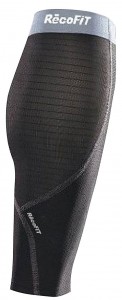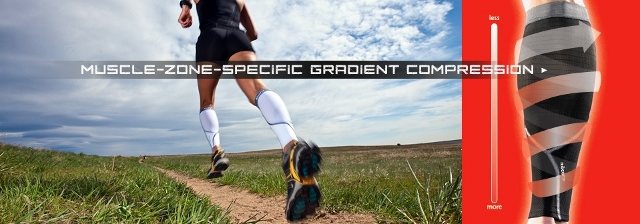There’s nothing quite like a new pair of compression sleeves to make you feel like a total gear junkie.
Especially RecoFit sleeves, which look like the Batsuit.

A few weeks ago I was sent a pair of calf sleeves to test from RecoFit. I’ve been wearing them regularly on easy runs, long runs, and marathon-specific workouts as I gear up for the Potomac River Run Marathon in early May.
I’ve previously written about compression gear where I reviewed the science behind it and my experiences with them. While I’m a relatively new convert to this type of gear, I’ve become a vocal proponent of wearing compression garments on the lower legs for a few different reasons.
Why Wear Compression Sleeves?
First and foremost, the most important benefit of compression gear is that it can improve blood flow at rest. In an extremity like the lower leg, this can aid the healing process after a tough workout or strenuous long run.
Runners have reported less perceived soreness and while the science might still debate this particular point, anecdotal evidence is piling up. As a runner, this is good enough for me. As a coach, I put it into the “why not try it?” category.
There’s two ways that you can wear calf sleeves:
During your workout. I love wearing compression gear during a run (side benefit: it keeps you warmer) for the simple reason that I like how it feels. It provides a snug, proprioceptive stimulus that I enjoy during a fast run.
There are claims that compression sleeves may reduce muscle vibrations and therefore, damage and post-workout soreness. But I’m not totally convinced. Several studies have concluded that wearing compression socks does not provide any physiological benefits during or following running.
Just remember that soreness is not necessarily a bad thing! I highly recommend this article by Steve Magness, former scientific advisor and assistant coach at the Nike Oregon Project, discussing the benefits of muscle damage. It’s why we train, after all.
Next, you can wear compression gear after your workout. This is where most of the benefits can be realized. Several studies have shown that it can improve venous blood flow, which will theoretically improve recovery when worn after a strenuous run. However, the exact reason that many runners experience faster recovery after wearing compression sleeves isn’t clear right now.
My advice is to wear it if you like the feeling during your run. And if you can, wear compression socks after you run to help the recovery process.
Calf sleeves are just like a foam roller, ice bath, massage, or elevation: they’re tools at your disposal to enhance your running experience.
RecoFit Calf Compression Sleeves – My Experience
First, I’ll say that RecoFit sleeves are a great composite material of 62% nylon, 35% spandex, and 2% carbon. The sleeves are thin and don’t trap heat as much as the Zensah socks that I only wear when it’s colder. The fabric sets RecoFit apart from the other manufacturers and I know I’ll continue to wear them as the weather heats up here in DC.
They call it “Resistex” fabric and claim that it improves performance. I’m not sold on that point, but here’s an interesting overview of their technology.
RecoFit also come in sizes that correspond to the circumference of your calf at its widest point (and are right and left leg specific). I measured myself at 15 1/4 inches, which puts me just over the medium size range of 13-15 inches. Still, I got the medium size and they seem to fit well, but not as tight as I’d like.
I prefer a fairly tight calf sleeve with a snug fit and these are a little too loose for my tastes. Compression gear for the lower legs works best if it’s graduated, meaning it’s tighter at the bottom near the ankle and gets gradually looser near the knee. While RecoFit claims it’s graduated, it’s difficult for me to determine where this occurs in the calf sleeve.

You’ll see in the pictures that the sleeve is made from two pieces of fabric: a back panel that hugs the calf muscle and another one that wraps around the rest of the shin and soleus. The back calf panel is tighter and less stretchy, while the wrap-around piece seems to be a uniform tightness the entire length of the sleeve.
Even though the graduated compression is unclear to me (they don’t list the exact compression in mmHg on the package or on the website), they seem to work just as well as my other calf sleeves and they’re rapidly becoming my favorite pair.
One of my favorite features, aside from the breathable material, is a loop of spandex at the top of the sleeve that holds it in place while you’re running. Every single pair of sleeves or compression socks have slowly shifted down my leg in the past at one point or another, but RecoFit has stayed in place on tempo runs and 21 mile long runs.
Should You Buy Them?
I’m not 100% sold on the many benefits claimed by the compression gear manufacturers, including:
- Faster oxygen delivery to the muscles
- Reduces muscle vibrations
- Delays fatigue and improves performance
- Enhances recovery post-exercise
They won’t transform your performances, magically make you healthy, or make you feel great in every workout. Nevertheless, compression socks can be a valuable tool in every runner’s toolbox of recovery techniques.
If you’re a gear junkie and love trying new types of running accessories, then you’ll love them even if you already own a few pairs of compression sleeves.
The slick look of RecoFit, the heat-wicking thin fabric, and the elastic band differentiate these calf sleeves from any other I’ve tried.
The best deal seems to be on Amazon, where RecoFit qualifies for free shipping.